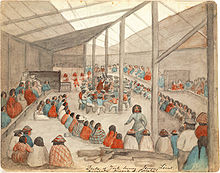Our website is made possible by displaying online advertisements to our visitors.
Please consider supporting us by disabling your ad blocker.
Gift economy

A gift economy or gift culture is an economic model, where goods are not sold, but they are given away, without an explicit agreement for immediate or future rewards.[1][2] There are social norms and customs about the exact way the gift is given. In a gift culture, gifts are not given in an explicit exchange of goods or services for money, or some other commodity or service. In contrast, in a barter economy or a market economy goods and services are exhanged for a received value, usually money.

Anthropologists discussed the nature of gift economies. Research began with Bronisław Malinowski's description of the Kula ring[3] in the Trobriand Islands during World War I.[4] The Kula trade appeared to be gift-like because Trobrianders would travel great distances over dangerous seas to give what were considered valuable objects without any guarantee of a return. Malinkowski had a discussion with French anthropologist Marcel Mauss: This showed that gift economy was more complex that they first thought. They also introduced a number of technical terms to describe the different forms of exchange. Some of these terms are reciprocity, inalienable possessions, and presentation.[5][6]
Anthropologists Maurice Bloch and Jonathan Parry think that the unsettled relationship between market and non-market exchange will attract most attention. Some authors argue that gift economies build community, while markets harm community relationships.[7]
Some things that make gift exhange different from other forms of exhange. Usually, the idea of property, and property rights are different. Sometimes gifting forms a distinct "sphere of exchange" that is an "economic system". Giving a gift always establishes a social relationship. The nature of giving a gift in a market economy,is very different from "prestations" typical of non-market societies. Gift economies also differ from related phenomena, such as common property regimes and the exchange of non-commodified labour.
- ↑ Cheal, David J (1988). "1". The Gift Economy. New York: Routledge. pp. 1–19. ISBN 0415006414. Retrieved 2009-06-18.
- ↑ Offer, A. (August 1997). "Between the Gift and the Market: The Economy of Regard" (PDF). The Economic History Review, New Series. 50 (3): 450–476. doi:10.1111/1468-0289.00064.
- ↑ Malinowski, Bronislaw (1922). Argonauts of the Western Pacific. London.
{{cite book}}: CS1 maint: location missing publisher (link) - ↑ Keesing, Roger; Strathern, Andrew (1988). Cultural Anthropology. A Contemporary Perspective. Fort Worth: Harcourt Brace and Company. p. 165.
- ↑ Mauss, Marcel (1970). The Gift: Forms and Functions of Exchange in Archaic Societies. London: Cohen & West.
- ↑ Weiner, Annette (1992). Inalienable Possessions: The Paradox of Keeping-while-Giving. Berkeley: University of California Press.
- ↑ J. Parry, M. Bloch (1989). "Introduction" in Money and the Morality of Exchange. Cambridge: Cambridge University Press. pp. 8–12.
Previous Page Next Page


